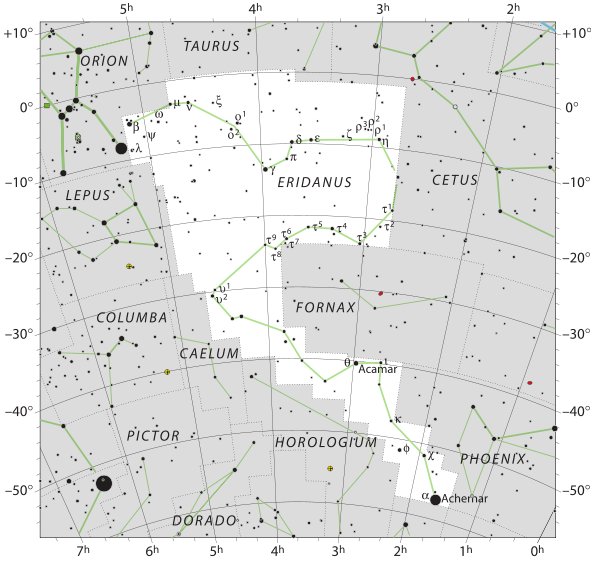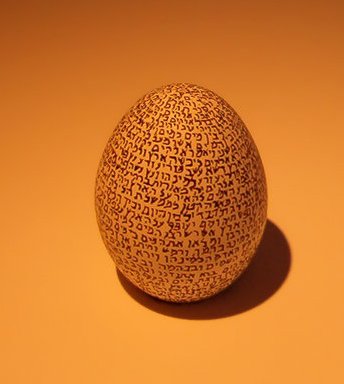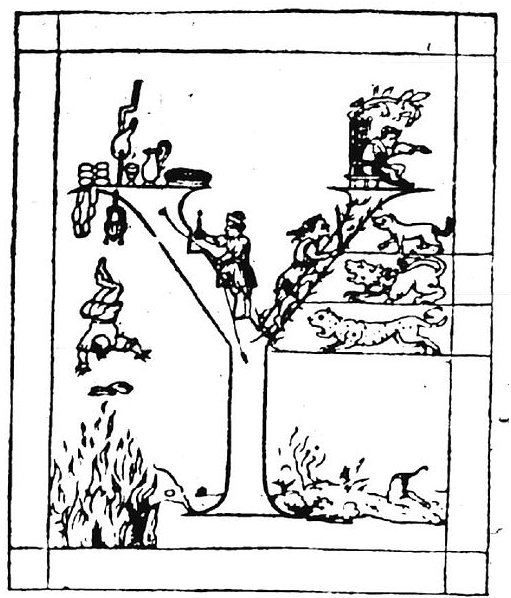Obviously the creators of Manuscript E have 'underlined' number 68 in a way which nobody could miss. Instead of continuing the sequence of page numbers uninterrupted from 1 to 100 a kind of break was inserted beyond page number 69 with a return to number 68:
What then could it mean? Possibly an allusiong to the behaviour of the planet Mars: ... Ancient people were fascinated with the periodic backward loops turned by Mars every two years ...
Right ascension day number *68 was at heliacal Aldebaran:
Therefore the pair 68-69 could correspond to the pair 1 ngeti uri and 2 ngeti tea, a pair of taro varieties. *68.5 at Theemin (υ² Eridani) might possibly also have induced the idea of a pair. Here the Eridanus river suddenly turns back before returning again:
Geti. A variety of taro. Vanaga. I have so far not found any explanation as to the meaning of the word geti, but there ought to be some resemblance to the meaning of gete: Gete. M.: Whakangete, to urge on a horse. Ngetengete, to make a clicking sound with the tongue. to click with the tongue, as to a horse; to chirrup. To express surprise or sorrow. Cf. ketekete, to express surprise or regret. H.: neke, an indistinct sound, as scratching on a rough board; to make the noise of scratching; to scratch. Cf. ekeeke, to be in pain; displeasure, arising from an offence; the feeling which one has when that which he prizes is spoken against or injured. T.: ete, to flinch; eteete, to be shocked disgusted, or ashamed. Cf. paete, to be made angry. To.: cf. ketekete, to chirrup; kekete, to chirp; to chatter. Text Centre. Right ascension *0 (at the time of rongorongo) was at the Navel of the Horse (Sirrah) and around (68.2 - 0.5) * 71 = ca 4800 years earlier the same position would have been occupied by Aldebaran. When the stars move ahead due to the precession it is because the Sun calendar stands still as observed and correlated with the seasons down on earth. We can therefore translate May 28 at the time of rongorongo with May 28 in the year 3149 BC:
... This pot depicts one of the Hero Twins (One-Ahaw in the Classic texts and One-Hunaphu in the K'iche' Popol Vuh) and a great bird who is trying to land in a huge ceiba tree heavy with fruit. This mythical bird is Itzam-Yeh, Classic prototype of Wuqub-Kaqix, 'Seven-Macaw', of Popol Vuh fame. In that story, in the time before the sky was lifted up to make room for the light, the vainglorious Seven-Macaw imagined himself to be the sun. Offended by his pride, the Hero Twins humbled him by breaking his beautiful shining tooth with a pellet from their blowgun. This pot shows One-Ahaw aiming at the bird as he swoops down to land in his tree. As Itzam-Yeh lands on his perch, the text tells us he is 'entering or becoming the sky'. This particular 'sky-entering' is not the one mentioned in the Palenque text. It is the final event that occurred in the previous creation before the universe was remade. Before the sky could be raised and the real sun revealed in all its splendor, the Hero Twins had to put the false sun, Itzam-Yeh, in his place. If the date on this pot corresponds to that pre-Columbian event, as we believe it does, then Itzam-Yeh was defeated on 12.18.4.5.0.1 Ahaw 3 K'ank'in (May 28, 3149 B.C.). After the new universe was finally brought into existence, First Father also entered the sky by landing in the tree, just as Itzam-Yeh did ... But at that ancient time (in 3149 BC) it was not Aldebaran who rose with the Sun in May 28 but another star. ... Counting the number of precessional days from the year 3149 BC to my assumed base line year for the rongorongo texts we will find Aldebaran at that time would have risen heliacally approximately (3149 + 1842) / 71 = 4991 / 71 = 70 right ascension days earlier than in May 28 (148), viz. around day 148 - 70 = 78 (19 March). This was neither at the Julian equinox (25 March), nor at the Gregorian equinox (21 March), nor at the astronomically average equinox (20 March). But from day 78 (19 March) to the beginning of a half-year in 1 July (182) the distance was 104 days. 78 = 3 * 26 and 182 = 7 * 26, which means that in 3149 BC there had been 4 * 26 = 104 days from heliacal Aldebaran to 1 July.
Thus the time frame at the Fall of the False Sun was 6 (= 70 - 64) right ascension days earlier than those *64 corresponding to the position of Hyadum II at the time of rongorongo. 6 * 71 = 426 and 3149 BC - 426 = 2723 BC when, according to a simple extrapolation without regard for the proper motions of the stars, Aldebaran (The Follower of the Pleiades) would have risen heliacally together with the Sun at the Julian equinox in MARCH 25 (84 = 7 * 12 = 6 * 14) ... Having grasped this meaning of the measure *70 right ascension days we can then advance to February 5: ... The dates in the myth of the defeat of Itzam-Yeh (Seven-Macaw), alias Ursa Major, could have referred to the same time frame as its dates for the following Creation and for the day when Hun-Nal-Ye became the sky: ... the Palenque scribes repeated Creation again and described it as 'it was made visible, the image at Lying-down-Sky, the First-Three-Stone-Place'. Then we learned that five hundred and forty-two days later ... Hun-Nal-Ye 'entered or became the sky' (och ta chan). This 'entering' event occurred on February 5, 3112 BC. February 5 came 542 days after May 21:
... From 21 May at the first 3-stone-place to 28 May (when Itzam-Yeh was defeated - although this happened 35 years earlier) there were 7 days, and likewise were there 7 glyph positions at the beginning of side a on the G tablet, with the last of them evidently illustrating a division into a back part and a front part. Thus it could have been a kind of 'Janus' place, with darkness at the back side and light in front ...
Next step should be August 13: ... Once again. According to the Mayas there were 542 days from the last Creation to the time when Hun-Nal-Ye entered (became) the sky (och ta chan). I have copied from my preliminary glyph type dictionary at toki: ... the Palenque scribes repeated Creation again and described it as 'it was made visible, the image at Lying-down-Sky, the First-Three-Stone-Place'. Then we learned that five hundred and forty-two days later (1.9.2 in the Maya system), Hun-Nal-Ye 'entered or became the sky' (och ta chan). This 'entering' event occurred on February 5, 3112 BC ... We can count from May 21 (141) to August 13 (225) and find this distance to be the same as the measure for the Julian equinox. 225 - 141 = 84 (12 weeks). I.e., 15 * 15 (= 225) - 7 * 12 (= 84) would have corresponded to right ascension day 141 - 80 = *61. At the time of rongorongo the Sun would here have risen at υ Persei. In the time frame of Bharani this was "April 10 (100): ... In a leap year the 'Egg' (Beid) would have been pushed ahead one day by force of an inserted day (Tua Tea) ...
... In three magnificent texts at the site of Koba, scribes recorded it as one of the largest finite numbers we humans have ever written. According to these inscriptions, our world was created on the day 4 Ahaw 8 Kumk'u. On this day all the cycles of the Maya calendar above twenty years were set at thirteen - that is to say, the cycles of 400 years, 8,000 years, 160,000 years, 32,000,000 years, and so on, all the way up to a cycle number extending to twenty places (2021 * 1360-day year). In our calendar, this day fell on August 13, 3114 BC:
To understand what this means, we need a little scale. The thirteens in this huge number act like the twelve in our cycles - the next hour after twelve is one. Thirteen changed to one as each of these cycles in the Maya calendar was completed, therefore, we have the following sequence:
At the time of rongorongo August 13 (and the Sun) was at the Knot (Ukdah):
|
|||||||||||||||||||||||||||||||||||||||||||||||||||||||||||||||||||||||||||||||||||||||||||||||||||||||||||||||||||||||||||||||||||||||||||||||||||||||||||||||||||||||||||||||||||||||||||||||||||||||||||||||||||||||||||||||||||||||||||||||||||||||||||||||||||||||||||||||||||||||||||||||||||||||||||||||||||||||||||||||||||||||||||||||||||||||||||||||||||||||||||||||||||||||||||||||||||||||||||||||||||||||||||||||||||||||||||||||||||||||||||||||||||||













